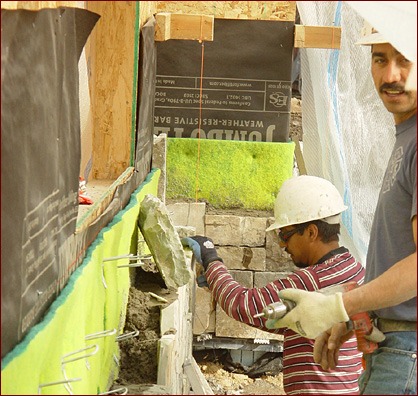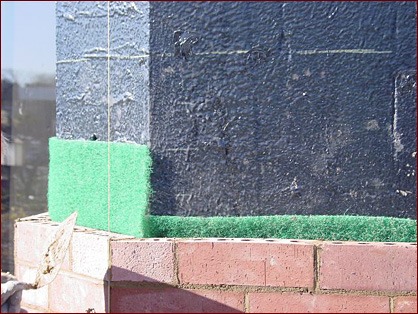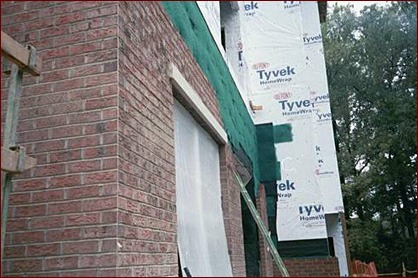December 2008
Flashing and Drainage
Water, Water, Everywhere?
Masonry walls have been around for a long time, and water has been around a lot longer. Problems occur when the latter interacts badly with the former and, as mason contractors know, preventing that bad interaction is an ongoing project.
With the growing use of new materials and products, such as stone veneer and concrete bricks, changes are developing in how drainage is provided and flashing is installed. Moving that ubiquitous water from entry to a non-damaging exit (providing proper drainage) is subject to a variety of factors, including the type of wall material, whether it is a single or double wythe, what the substrate is, and where, geographically, the building is positioned.
“In cavity wall construction, we like to have a continuous area for drainage and ventilation, meaning at no point is it obstructed with any element, mortar or other debris that may be getting put into the cavity,” says Sarah B. Atkins, president of CavClear in Hudson, Wisc. “The most common thing that would obstruct the cavity, of course, is excess mortar that gets expressed into the cavity space during the construction of the exterior brick wall. Anything that blocks any air space or anything that is making contact with both the inside of the brick and the back-up or insulation or substrate is going to block moisture from being able to flow out of the system, and that impedes the ventilation of the cavity.”

![]()
CavClear cavity walls have a continuous area for drainage and ventilation.
CavClear developed insulation and a masonry system intended to prevent mortar, in particular, from being able to make contact with the backup or substrate.
“Excess mortar is held in proximity to the mortar joint and will push slightly into our masonry mat, but it won’t be able to make contact with the back-up,” Atkins says, “so, you still have an area where moisture can drain and air can ventilate.”
The major method of water control within the cavity is the use of flashing. Flashing, at a minimum, must come through the wall to remove moisture that gets behind the outer wythe.
The technical notes of the Brick Industry Association (BIA) address flashing a masonry wall (www.bia.org/bia/technotes/t7a.pdf):
“Selection of a proper flashing material is of utmost importance, because the flashing is a critical element to the drainage of water that may penetrate the wall system. Flashing materials should be waterproof, durable and resist puncture and cracking during and after construction. Because flashing may be installed in advance of the exterior brick wythe, it should be able to endure some exposure to ultraviolet (UV) light without significant deterioration. The flashing should also resist damage from contact with metal, mortar or water and be compatible with adjacent adhesives and sealants. In general, thicker flashings are more durable, but may be more difficult to form.
Flashing materials generally fall into three categories: sheet metals, composite materials (combination flashings) and plastic or rubber compounds. The selection is largely determined by cost and suitability. It is suggested that only superior quality materials be selected, since replacement in the event of failure may be expensive. Materials such as polyethylene sheeting, asphalt-impregnated building felt, building paper and house wraps should not be used as flashing materials. These materials are easily damaged during installation and in many cases, turn brittle and decay over time.”
Chris Bupp, head of the Educational and Architectural Services Division at Hohmann and Barnard in Hauppauge, N.Y., adds, “The recommendation has been that you should go beyond the face of the brick or the veneer material one-quarter of an inch to form a drip edge. The BIA has, in the few last years, revised that to say that, while that is still the recommendation, they now have a minimum on their requirements, and that is that flashing comes at least out flush to the outside face of the brick.”
The flashing industry is responding to that requirement. Extending material beyond the face of the brick is normally done with a metal drip edge or some type of drip edge material. Because of the requirement of getting it flush to face, if that’s the chosen method, you need to look at materials that are UV stable and can be left exposed permanently without any kind of negative to the material or to the wall’s visual impact. In addition, care to match either the brick color or the mortar color makes the drip point less noticeable, and that makes the architect happy.
“Asphalt-based products or an asphalt-coated copper material are problematic,” says Bupp. “If you try to bring it to the face of the brick, the asphalt might actually heat up enough that it could liquefy and, potentially, bleed out of the joint and down the face of the building. So, our industry is looking at things like clear adhesives that have much higher melting points, so that it’s not an issue.”
Clear-coating systems that go over copper material are other options. Another concern with asphalts, Bupp says, is staining, if you’re using light-colored masonry as a veneer material.

![]()
Image courtesy of CavClear
“That’s one of the areas, from a product standpoint, that we see changing,” Bupp says. “We’ve developed clear adhesive products with melting points near the 400-degree Fahrenheit mark, so there’s never a concern about the material actually liquefying and bleeding out. I think that’s an advantage, and the fact that it’s not asphalt eliminates the staining issue. We think that’s a step in the right direction.”
Another subtle change is slowly happening: the development of more easily installable products. “One of the products that we see used a lot is a peel-and-stick flashing that actually has a built-in adhesive,” says Bupp. “It just makes life a lot easier for the contractor to be able to slap pieces together, detail inside and outside corners, and create watertight areas around door and window openings.”
Many older types of material are not easy to use and, as the old adage goes, “If it’s not easy, it’s not getting done,” or, at least not getting done right. Another factor involving ease-of-use is time. The longer it takes to get the job done, the further out payment is for the job. Pre-formed corners in copper save a lot of time when using that material; peal-and-stick flashing that incorporates most of the elements needed for the job are another approach.
Combining the two methods are pre-assembled panels developed by Mortar Net in Gary, Ind., known as TotalFlash. According to Earl Bickett, general manager of Mortar Net, “TotalFlash incorporates all of the traditional moisture control methods into pre-assembled panels. So, rather than having a variety of loose components show up at the jobsite, either on the same day, different days, or a week apart, TotalFlash comes in five-foot panels instead of rolls. The termination bar is attached at the factory; the drip edge is attached at the factory; and the moisture collection device and weep system are attached at the factory. So, they are easier to handle and more reliably attached.”
Often, what is not taken into account is that the jobsite can be extremely dirty. There are dust, rain, mud, oil, and other chemicals and substances. It is difficult to cut things straightly in the field, and that means it is unusual if flashing is cut straightly. On the other hand, all the corners and edges on the TotalFlash panels come perfectly straight, from the factory.
“The lap joint is going to be six inches every time,” says Bickett. “When field conditions make it difficult to enforce a consistent lap joint and consistent length of product, these panels are a big time saver.”
While we hear a lot about green buildings, we often over look the green aspects of the materials we use in the buildings. Bickett acknowledges the importance of this movement, “Our components use recycled materials. At the building’s ‘end of life,’ which hopefully would be 100 years or more, the components are recyclable: The stainless steel, the plastic and some of the other components can all be recycled.”

![]()
Image courtesy of CavClear
A masonry building should last 50 to 100 years, Bickett says. “The real issue is to build it with high-quality components and systems that are not going to fail. We are involved on a building that is only three years old, where all the brick is being removed because of faulty installation or design. They built a masonry building, and now we have a lot of energy being used to remake it. There are people driving to a jobsite using gasoline and energy, and delivering materials to a jobsite. This should not have happened for another 100 years. So that is a big issue for us ??? to build it so that it lasts, the green aspects of it remain sustainable, and it is built properly.”
Speaking of green, several other companies are noting their credentials in this area. For example, Atkins of CavClear says, “The material that we use is 100 percent recycled plastic. That helps our environment by finding a use for post-consumer plastics. Our products, the CavClear masonry mats and stone mats, as well as weep vents, provide points toward LEED credits in the recycled materials category. Both mats also help with thermal efficiencies.”
Regardless of the material used, picking the right flashing and drainage materials and designs is critical for long-lasting, stain- and efflorescence-free walls. Don’t get stuck in the past. Look at what is available in new approaches to flashing and drainage.